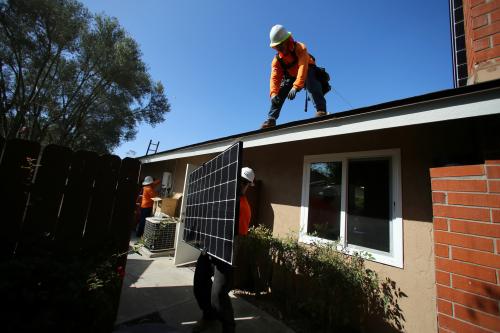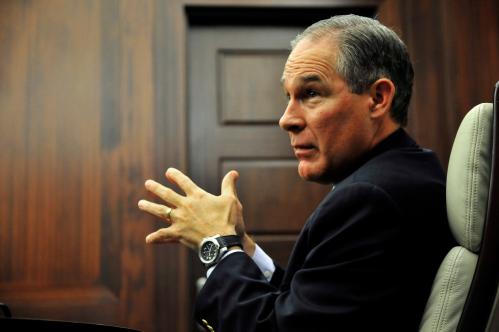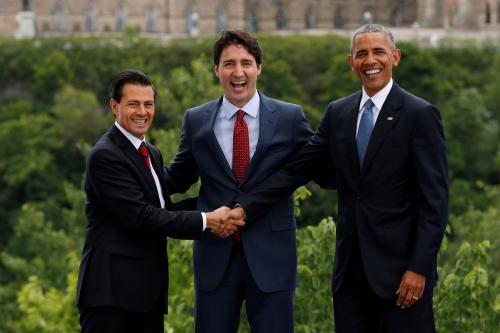While I am far from being a supporter of President Donald Trump, I thought I would like to give a nod to the White House in this post, since they’ve declared this “Energy Week,” with a focus on local and state energy issues. And, with the summer driving season now rolling, what could be more apt than sharing a story about an energy-efficient American car driven by ecologically-minded Americans?
Recently, my wife and I took the leap and leased a Chevy Bolt, a fully-electric car with no gas motor. It’s not a hybrid, but it does go over 240 miles on a charge. What have we learned?
First, we may never go to a gas station again. This is a totally viable car for 99 percent of our driving. If we’re going on a very long trip, we might take the Bolt just for the adventure and experience of it, but we’ll probably rent a gas car or use our old station wagon. When that dies, however, we’re thinking about another electric.
Second, nearly all our charging has been in the driveway. You don’t need charging stations out there very often. With the great range of the Bolt, there’s no need really to go searching for charging stations. Still, there are some free charging stations available—which is like getting free gas.
Third, buy the “Level 2” quick charger for your house and get it installed. This means about a $600 investment and an electrician to put in a 220-volt 40 amplifier plug outside your house. The “trickle charger” 110-volt cord that comes with the car only adds about 4 miles worth of driving per hour of charging. That means if you’re under 100 miles on your charge, it could be plugged in for a couple days. The Level 2 charger would fill it overnight from empty.
Fourth, download the ChargePoint app to your phone and get an account card. It features maps pinpointing the locations of charging stations, which are (reassuringly) all over the place.
Fifth, driving such a quiet car is really wonderful.
Sixth, consider leasing instead of buying, since who knows what will be available in a couple years. That’s why we chose to lease. It’s $327 a month, with taxes, with 15,000 miles a year included. That was with a $2,000 down payment. With Rhode Island’s rebate, we are getting $2,500 back. These won’t last. Deals from all the main dealers in Southern New England are listed under the Drive Green program, but I bet dealers could be persuaded to match these offers anywhere.
Seventh, the Chevy Bolt is a generation ahead of everything else that’s available now in this price range. I was a few minutes away from buying or leasing a Nissan Leaf, but checked out the Chevy dealership next door before deciding, and I’m glad I did. The other affordable electrics (leaving available Teslas aside) only have around a 100-mile range. My wife drives that many miles quickly, and it’s reassuring to not be near the bottom of the battery charge. The Tesla 3 sounds great, but it’s not available yet and there’s a 300,000 person waiting list. And who knows how it’ll perform. The Bolt is here now, and it’s a very good car. With the current $7,500 federal tax credit, it’s just under $30,000. But again, the lease seems like a better idea.
Eighth, electrification is the only way forward for transportation that can get us off fossil fuels right now, and climate change and public health matter a lot to us. The U.S. Environmental Protection Agency rating for the Bolt is 119 miles per gallon. This varies a lot by the part of the country in which one is charging the car, but according the Union of Concerned Scientists, it’s better than a gas car no matter where it’s being charged, and the entire grid is quickly getting greener. We seem to use a lot more juice than we used to, but we buy “green up” electricity through a local non-profit, so for every electron we take out of the grid at the house, they put one electron in from wind power generated right here in New England. I work with staffers at People’s Power and Light, so I know this is legit.
Ninth, an estimated 53,000 people die each year in the U.S. from vehicle exhaust, according to a new MIT study. We care about climate change and public health, and you should too.
Finally, the only way to actually stop the fossil fuel companies from destroying our planet is to simply stop buying their products. Divestment from fossil fuels would help and should be done by individuals, churches, universities, and pension funds, but even if Exxon and other fossil majors publicly say they are for carbon taxes and for staying in the Paris Agreement, they often privately fund corrosive denialist think tanks, industry organizations, and public relation firms with hundreds of millions of dollars to undermine the ambitious action on climate that we desperately need. The only way to stop this in the age of Citizens United is to stop the flow of money to them. Otherwise we are all responsible for their power.
Last thoughts, on costs and emissions: The ultimate goal is for there to be “variable rate charging,” where you could program the car or charger to only fill up the battery when the electricity rates are the lowest on the grid. This would incentivize people to charge and run their clothes dryers and dishwashers at night when the wind is blowing but no one’s using electricity. This isn’t available in my state yet, but we’re pushing for that. The Juice Box charger can be set it up to charge when there’s more renewable energy on the grid. That would mean more to me if I wasn’t getting 100 percent renewable electricity already. But for others, it’s potentially a big contribution to reducing our nation’s emissions of greenhouse gases.
Finally, there is the cost of maintaining these new electric cars, which could be sharply lower than gas-powered vehicles. There is no oil to change. No muffler to repair. No carburetor, no turbocharger, no fuel lines. There are two thousand moving parts in a gas-powered car, and only 20 in an electric one.
So I’m sold on these things, and think that there will be a huge surge in the next three years in their uptake. With the Bolt and others about to come out, electric cars are viable and affordable. They can help us rapidly address climate change, and clean up our urban air, which gets especially unhealthy every summer. Imagine a heat wave without an air quality alert—since we’re headed to more hot days with a warming climate, we need to make this switch quickly. New electric buses and fleet vehicles could be transformative for urban air quality and children’s health, in the U.S. and around the world.










Commentary
It’s Energy Week: Here are 10 lessons about buying or leasing an electric car
June 27, 2017